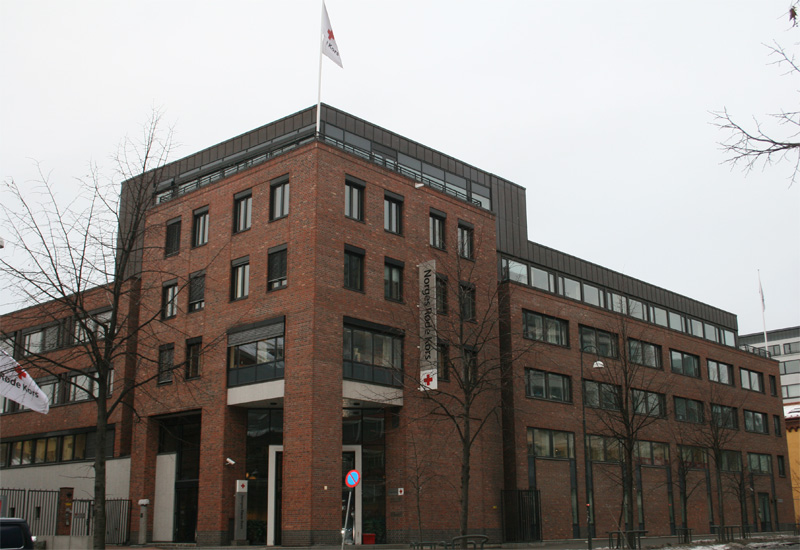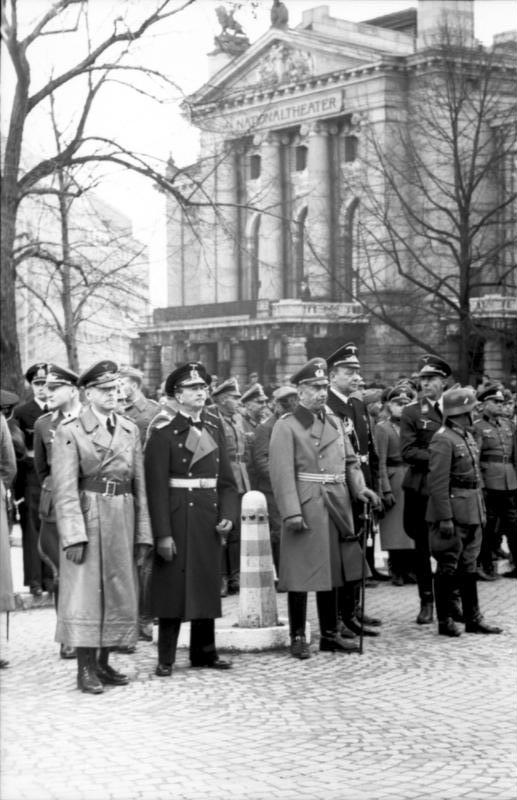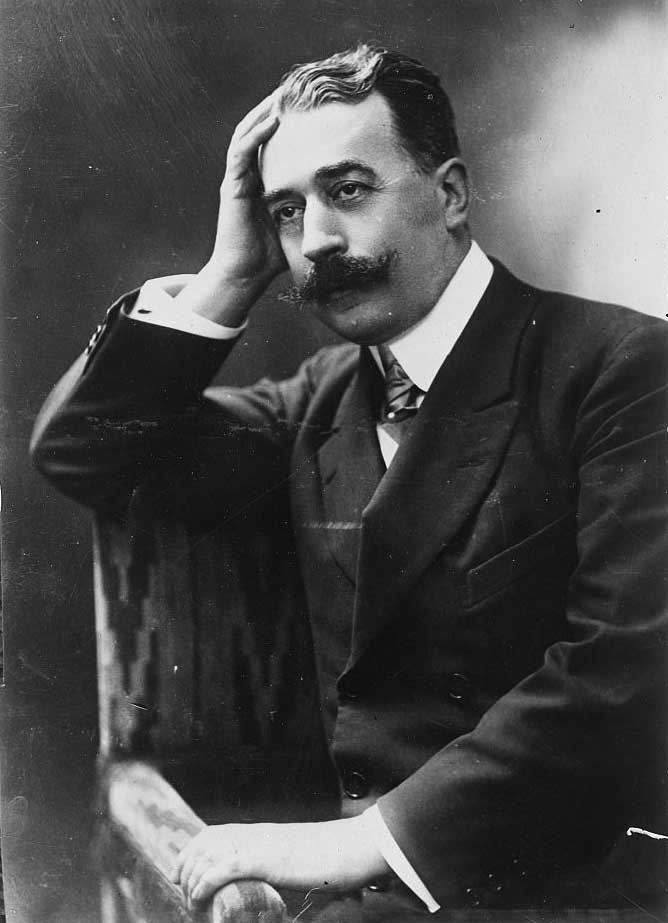|
Erling Steen
Erling Steen (6 March 1891 – 22 September 1961) was a Norwegian businessman, humanitarian leader and member of the Norwegian resistance movement in World War II. Personal life Steen was born in Kristiania as a son of Johan Steen (1856–1934) and Marie Eveline Gulbranson (1861–1942). He was a grandson of Emil Steen (1829–1884), a nephew of Emil Jr. and Christian Steen, and a first cousin of Fredrik, Nils and Emil Steen. His sister Sigrid married Hans Thomas "Hassa" Horn. In November 1916 Erling Steen married Helene C. Laurantzon, a wholesaler's daughter. The marriage ended in August 1940. In the same month he married Kathleen Ragnhild Collett, née Falsen and divorcee of Johan Collett. This marriage ended in June 1949. The same month Steen entered his third marriage, this time to Alix Dorry Sophie Boyesen, née Theslöf and divorcee of diplomat Jens Boyesen. He resided at Lagåsen in Bærum. Career Steen finished his secondary education in 1910, graduated from Kr ... [...More Info...] [...Related Items...] OR: [Wikipedia] [Google] [Baidu] |
Humanitarian
Humanitarianism is an active belief in the value of human life, whereby humans practice benevolent treatment and provide assistance to other humans to reduce suffering and improve the conditions of humanity for moral, altruistic, and emotional reasons. One aspect involves voluntary emergency aid overlapping with human rights advocacy, actions taken by governments, development assistance, and domestic philanthropy. Other critical issues include correlation with religious beliefs, motivation of aid between altruism and social control, market affinity, imperialism and neo-colonialism, gender and class relations, and humanitarian agencies. A practitioner is known as a humanitarian. An informal ideology Humanitarianism is an informal ideology of practice; it is "the doctrine that people's duty is to promote human welfare." Humanitarianism is based on a view that all human beings deserve respect and dignity and should be treated as such. Therefore, humanitarians work towards ... [...More Info...] [...Related Items...] OR: [Wikipedia] [Google] [Baidu] |
Examen Artium
Examen artium was the name of the academic certification conferred in Denmark and Norway, qualifying the student for admission to university studies. Examen artium was originally introduced as the entrance exam of the University of Copenhagen in 1630. The University of Copenhagen was the only university of Denmark-Norway until The Royal Frederick University in Christiania was founded in 1811. In Norway, examen artium was formally discontinued after the 1982 class (but the term is still sometimes used informally to denote the diploma from today's " videregående skole"). Norway Typically after their tenth and final year of compulsory primary school education, students applied for admission to a three-year programs of studies, called "lines" at schools called ''gymnas'' within their counties. The curricula for the lines included a core of general studies topics, including Norwegian, mathematics, history, English, physical education, and one natural science subject. The curri ... [...More Info...] [...Related Items...] OR: [Wikipedia] [Google] [Baidu] |
Norwegian Red Cross
The Norwegian Red Cross (''Norges Røde Kors'') was founded on 22 September 1865 by prime minister Frederik Stang. In 1895 the Norwegian Red Cross began educating nurses, and in 1907 the Norwegian Ministry of Defence authorized the organization for voluntary medical aid in war. The Norwegian Red Cross was one of the first national organizations in the International Red Cross. The organization now has 150,000 members and provides a variety of humanitarian services, including care for old and the infirm, prisoner visits, outdoor rescue, and international work. Presidents *1865–1880 Frederik Stang *1880–1889 Christian August Selmer *1889–1905 Johan Fredrik Thaulow *1905–1908 Ernst Motzfeldt *1908–1912 Andreas Martin Seip *1912–1913 Christian Wilhelm Engel Bredal Olssøn *1913–1917 Hans Jørgen Darre-Jenssen *1917–1922 Hieronymus Heyerdahl *1922–1930 Torolf Prytz *1930–1940 Jens Meinich *1940–1945 Fridtjof Heyerdahl *1945–1947 Nikolai Nissen Paus *194 ... [...More Info...] [...Related Items...] OR: [Wikipedia] [Google] [Baidu] |
Grini Concentration Camp
'', '' no, Grini fangeleir'', location= Bærum, Viken, Norway, location map=Viken#Norway, built by=Norway, original use=Constructed as a women's prison, operated by=Nazi Germany, notable inmates=List of Grini prisoners, liberated by=Harry Söderman, construction=1938–1940, image size=300px Grini prison camp ( no, Grini fangeleir, german: Polizeihäftlingslager Grini) was a Nazi concentration camp in Bærum, Norway, which operated between 1941 and May 1945. Ila Detention and Security Prison is now located here. History Grini was originally built as a women's prison, near an old croft named ''Ilen'' (also written ''Ihlen''), on land bought from the Løvenskiold family by the Norwegian state. The construction of a women's prison started in 1938, but despite being more or less finished in 1940, it did not come into use for its original purpose: Nazi Germany's invasion of Norway on 9 April 1940, during World War II, instead precipitated the use of the site for detention by the ... [...More Info...] [...Related Items...] OR: [Wikipedia] [Google] [Baidu] |
Møllergata 19
Møllergata 19 is an address in Oslo, Norway where the city's main police station and jail was located. The address gained notoriety during the German occupation from 1940 to 1945, when the Nazi security police kept its headquarters here. This is also where Vidkun Quisling in 1945 surrendered to the legitimate Norwegian government and was imprisoned. History Although the site was owned by the city government since the 17th century, it was not until 1857 that the city of Kristiania decided to put the site to use as a center for law enforcement. Based on the drawings by Jacob Wilhelm Nordan, construction for the complex started in 1862 and was finished in 1866. Facing Youngstorget (which then was called Nytorvet), was the police station and courtrooms; behind these was the jail. A floor was added in the late 1870s. Though some of the capacity was moved to a new prison in Åkebergveien (known as "Bayern"), the structure continued to serve as a prison and central police station u ... [...More Info...] [...Related Items...] OR: [Wikipedia] [Google] [Baidu] |
Paul Christian Frank
Paul Christian Frank (28 November 1879 – 21 February 1956) was a Norwegian barrister, politician, organizer and non-fiction writer. He was born in Kristiania (present-day Oslo, Norway). He was CEO of the trade association from 1920 to 1952. Frank is particularly remembered for his tireless agitation against governmental price controls. He was decorated Knight, First Class of the Order of St. Olav in 1946, Knight of the Order of the Dannebrog, Knight of the Order of the Polar Star and Commander of the Order of Vasa. During the occupation of Norway by Nazi Germany, Frank was imprisoned in Møllergata 19 from June to July 1941, then in Grini concentration camp from 12 September 1941 to 26 November 1942. He was arrested a third time in June 1944; after a month in Åkebergveien he was incarcerated in Grini from July to August 1944. He had endeavored to keep ''Norges Handelsstands Forbund'' from being usurped by the Nazis. His organization was one of forty-three to protest nazi ... [...More Info...] [...Related Items...] OR: [Wikipedia] [Google] [Baidu] |
Henning Bødtker
Henning Bremer Bødtker (14 August 1891 – 19 November 1975) was a Norwegian jurist and civil servant. He was the Attorney General of Norway from 1945 to 1962. Personal life He was born in Svelvik as a son of ship captain Jacob Bødtker (1847–1923) and Hilda Tofte (1853–1943). He is a second cousin of professor Adam Trampe Bødtker. In 1922 he married Swedish citizen Dagmar von Sydow. Their daughter who was also named Dagmar married landowner and politician Carl Oscar Collett. Career He finished his secondary education in 1909 and graduated from the Royal Frederick University with the cand.jur. degree in 1913. He was a law clerk and junior solicitor from 1914 to 1918, and also chaired the Norwegian Students' Society in 1916. From 1919 he was a practising lawyer in Oslo. He worked as a secretary for the Norwegian Bar Association from 1929 to 1937, also editing ''Norsk Sakførerblad'' for the last six years. He became a board member in the Norwegian Bar Association in 193 ... [...More Info...] [...Related Items...] OR: [Wikipedia] [Google] [Baidu] |
Protest Of The 43
A protest (also called a demonstration, remonstration or remonstrance) is a public expression of objection, disapproval or dissent towards an idea or action, typically a political one. Protests can be thought of as acts of cooperation in which numerous people cooperate by attending, and share the potential costs and risks of doing so. Protests can take many different forms, from individual statements to mass demonstrations. Protesters may organize a protest as a way of publicly making their opinions heard in an attempt to influence public opinion or government policy, or they may undertake direct action in an attempt to enact desired changes themselves. Where protests are part of a systematic and peaceful nonviolent campaign to achieve a particular objective, and involve the use of pressure as well as persuasion, they go beyond mere protest and may be better described as a type of protest called civil resistance or nonviolent resistance. Various forms of self-ex ... [...More Info...] [...Related Items...] OR: [Wikipedia] [Google] [Baidu] |
Josef Terboven
Josef Terboven (23 May 1898 – 8 May 1945) was a Nazi Party official and politician who was the long-serving ''Gauleiter'' of Gau Essen and the ''Reichskommissar'' for Norway during the German occupation. Early life Terboven was born in Essen, the son of minor landed gentry. The family name comes from the Low German ''dar boven'' ("up there"), referring to a farmstead on a hill. Josef Terboven attended ''volksschule'' and ''realschule'' in Essen until 1915 and then volunteered for military service in the First World War. He served with ''Feldartillerie Regiment'' 9 and then with the nascent air force. He was awarded the Iron Cross, 1st and 2nd class, and attained the rank of Leutnant before being discharged on 22 December 1918. He studied law and political science at the University of Munich and the University of Freiburg, where he first got involved in politics. He dropped out of the university in 1922 without earning a degree and trained as a bank official in Essen, working ... [...More Info...] [...Related Items...] OR: [Wikipedia] [Google] [Baidu] |
Reichskommissar
(, rendered as "Commissioner of the Empire", "Reich Commissioner" or "Imperial Commissioner"), in German history, was an official gubernatorial title used for various public offices during the period of the German Empire and Nazi Germany. German Empire Domestic In the unified German Empire (after 1871), Reichskommissars were appointed to oversee special tasks. For instance, there was a Reichskommisar for emigration (''Reichskommissar für das Auswanderungswesen'') in Hamburg. Presumably the same title is rendered as "German Imperial Commissioner" in the case of Heligoland, a strategically located once-Danish island in the North Sea, formally handed over to Germany by the UK on 9 August 1890 (under the Heligoland–Zanzibar Treaty) and on 15 December 1890 formally annexed to Germany (after 18 February 1891 part of the Prussian province of Schleswig-Holstein): 9 August 1890 – 1891 Adolf Wermuth (b. 1855 – d. 1927) Colonial The title of Reichskommissar was used during the ... [...More Info...] [...Related Items...] OR: [Wikipedia] [Google] [Baidu] |
Occupation Of Norway By Nazi Germany
The occupation of Norway by Nazi Germany during the Second World War began on 9 April 1940 after Operation Weserübung. Conventional armed resistance to the German invasion ended on 10 June 1940, and Nazi Germany controlled Norway until the capitulation of German forces in Europe on 8 May 1945. Throughout this period, a pro-German government named Den nasjonale regjering (English: the National Government) ruled Norway, while the Norwegian king Haakon VII and the prewar government escaped to London, where they formed a government in exile. Civil rule was effectively assumed by the '' Reichskommissariat Norwegen'' (Reich Commissariat of Norway), which acted in collaboration with the pro-German puppet government. This period of military occupation is, in Norway, referred to as the "war years", "occupation period" or simply "the war". Background Having maintained its neutrality during the First World War (1914–1918), Norwegian foreign and military policy since 1933 was large ... [...More Info...] [...Related Items...] OR: [Wikipedia] [Google] [Baidu] |
International Chamber Of Commerce
The International Chamber of Commerce (ICC; French: ''Chambre de commerce internationale'') is the largest, most representative business organization A business entity is an entity that is formed and administered as per corporate law in order to engage in business activities, charitable work, or other activities allowable. Most often, business entities are formed to sell a product or a servi ... in the world. Its over 45 million members in over 100 countries have interests spanning every sector of private enterprise. ICC's current chairman is Ajaypal Singh Banga and John W.H. Denton AO is the current Secretary General. ICC has three main activities: rule setting, dispute resolution, and policy advocacy. Because its member companies and associations are themselves engaged in international business, ICC has unrivalled authority in making rules that govern the conduct of business across borders. Although these rules are voluntary, they are observed in thousands of transactions e ... [...More Info...] [...Related Items...] OR: [Wikipedia] [Google] [Baidu] |






